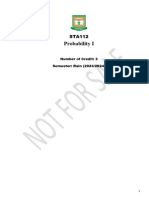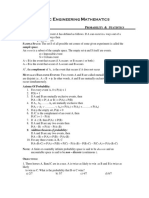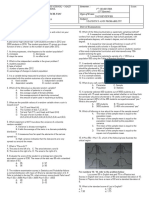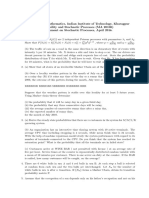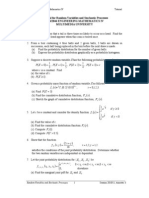Probability
Uploaded by
vknn875Probability
Uploaded by
vknn875PROBABILITY
CHAPTER-12
PROBABILITY
Random Experiment
If an experiment can be repeated under essentially the same conditions and the result is not
certain, the experiment is said to be a random experiment or trial.
Sample Space
The set of all simple events in a random experiment is said to be a sample space. Every element in a
sample space is called a sample point.
Every subset of a sample space is said to be an event.
To every simple event, there exists one and only one sample point.
Sample space of a random experiment is denoted by S.
Event
Each of the possible outcomes are known as events.
Example : tossing a coin is trial, getting head or tail is an event.
Compound Events
An event which can further be split into simple events is said to be a compound event.
Example : When a die is thrown getting an even number is a compound event; because it can further
be divided into events getting 2 dots, 4 dots, 6 dots.
Mutually Exclusive Events
Events are said to be mutually exclusive, if the happening of one of the events prevents the happening
of all other in the same trial.
Example : In throwing a die all six faces numbered 1, 2, 3, 4, 5, 6 are mutually exclusive since any
outcome rules out the possibility of getting any other outcome.
Exhaustive Events
The total number of possible outcomes in any trial is known as exhaustive events.
Example : (i) In tossing a coin, there are two exhaustive events namely getting head or tail
(ii) In throwing a die, there are six exhaustive cases, for any one of the surface
may turn up.
Equally Likely Events
Events are said to be equally likely, if there is no reason to expect any one in preference to any other.
Example : When a card is drawn from a well shuffled pack : every card is equally likely.
Favourable Cases or Events
The events which entail the happening of an event are said to be favourable to that event.
Example : In throwing a die the favourable events for getting even number of dots are
(i) getting 2 dots
(ii) getting 4 dots
(iii) getting 6 dots
Independent and Dependent event
When the experiments are conducted in such a way that the occurence of an event in one trial does
not have any effect on the occurence of this or other events at a subsequent experiment, then the events are
said to be independent. Events which are not independent are called dependent events.
TRIVANDRUM | KOLLAM | ERNAKULAM | MARTHANDAM
PROBABILITY
Classical Definition of Probability
If an experiment has n mutually exclusive, equally likely and exhaustive cases out of which m are
favourable to the happening of the event E, then the probability of the happening of E is denoted by P(E) and
m Number of cases favourable to E
is defined as: P(E) = n Total number of cases
Note (i) If a sample space has n elements, then the number of possible events is 2n. This is
denoted P(S)
(ii) The number of sample points in the event E is denoted by n(E)
Complementary Events
The event 'E' occurs and the event 'E does not occur' are called complementary events. The event E
does not occur is denoted by Ec and is read as compliment of E
Note that P(E) + P(Ec) = 1
P(Ec) = 1 - P(E)
Note
(1) If E1, E2, E3,...................En are n mutually exclusive events and P(E1), P(E2),
P(E3), ...........,P(En) be their respective probabilities, then
P(E1 E2 E3 ............ En) = P(E1) + P(E2) + ....... + P(En)
(2) The probability of the occurence of atleast one of the two events E and F is given by
P(E F) = P(E) + P(F) - P(E F)
Note
P (happening of at least one of the events A & B) = P (A B)
P (simultaneous happenng of the events A & B) = P (A )
P (not happening of the event A) = P ( A) = 1 __ P (A)
P (happening of the event A but not the event B) = P ( A B) = P (A) __ P (A B)
P (happening of neither the event A nor the event B) = P ( A B ) = P ( A B)
= 1 __ P (A B)
Note
If the events A & B are mutually exclusive, then P (A B) = P (A) + P(B)
If the events A & B an exhaustive, then P (A B) = 1
If the events A & B are mutually exclusive and exhaustive, then P(A) + P(B) = 1
Level-I
1. A natural number is selected at random from the set of natural numbers. The probability
that it is 1 is
(a) 1/100 (b) 1/101 (c) 1/99 (d) 0 (e) none
2. Three numbers are chosen from 1 to 30. The probability that they are not consecutive is
144 143 142 139
(a) (b) (c) (d) (e) none
145 145 145 145
TRIVANDRUM | KOLLAM | ERNAKULAM | MARTHANDAM
PROBABILITY
3. One letter is taken from the word 'PROBABILITY'. The probability that the selected letter
is a vowel is
4 4 2 3 3
(a) (b) (c) (d) (e)
11 165 55 11 10
4. The letters of the word ORIENTAL are arranged in all possible ways and one such arrangement is
taken at random. The chance that the consonants and the vowels occur alternately is
(a) 1/70 (b) 2/35 (c) 4/35 (d) 3/35 (e) 1/35
5. The probability that four S's occur together in an arrangement of the letter of the word MISSISSIPPI
is
(a) 8/165 (b) 74/165 (c) 16/165 (d) 32/165 (e) 4/165
6. An urn contains 7 green and 5 yellow balls. Two balls are drawn at a time. The probability that both
balls are of same colour is
(a) 1/33 (b) 5/33 (c) 7/22 (d) 4/33 (e) 31/66
7. A pack of cards contains 4 aces, 4 kings, 4 queens and 4 jacks. Two cards are drawn at random.
The probability that atleast one of them is a king is
(a) 1/5 (b) 3/16 (c) 9/20 (d) 1/9 (e) 1/16
8. A team of 5 persons is to be selected out of 5 men, 3 women and 2 children. The probability that at
least two of them are women is
105 21 126 1 7
(a) (b) (c) (d) (e)
252 252 252 3 52
9. Two natural numbers are selected from the set of natural numbers 1, 2, 3, .........., 50. The probability
that both numbers are prime is
(a) 3/10 (b) 15/49 (c) 3/35 (d) 6/35 (e) None
10. Two natural numbers are selected from the set of natural numbers 1, 2, 3, .........., 50. The probability
that both numbers are composite is
(a) 17/35 (b) 561/1225 (c) 561/3675 (d) 17/3675 (e) None
11. The probability that atleast one of the events A and B occurs is 0.5. If A and B occur simultaneously
with probability 0.2, then P( A ) + P( B ) is
(a) 0.4 (b) 0.8 (c) 1.2 (d) 1.4 (e) 1.3
12. A card is drawn from a well shuffled deck of 52 cards. The probability of drawing a card which is
neither spade nor queen is
(a) 4/13 (b) 17/52 (c) 9/13 (d) 37/52 (e) None
13. In a single throw of two dice, the probability of getting a total of 7 or 9 is
(a) 4/18 (b) 1/3 (c) 5/18 (d) 7/18 (e) 1/2
14. A coin is tossed once. If a head comes up, then it is tossed again and if a tail comes up, a die is
thrown. The number of points in the sample space of the experiment is
(a) 24 (b) 12 (c) 4 (d) 8 (e) 7
15. Two dice are thrown simultaneously. The probability of getting a total score of 7 is
(a) 1/6 (b) 5/36 (c) 7/36 (d) 1/4 (e) 1/9
TRIVANDRUM | KOLLAM | ERNAKULAM | MARTHANDAM
PROBABILITY
16. The probability that a leap year selected at random has 53 sundays
(a) 1/7 (b) 2/7 (c) 6/7 (d) 1 (e) none
17. The probability that a non-leap year selected at random has 53 sundays
(a) 1/7 (b) 2/7 (c) 6/7 (d) 1 (e) 0
18. Probability of getting a number between 1 and 100, which is divisible by 1 and itself only, is
(a) 1/4 (b) 25/99 (c) 25/98 (d) 26/98 (e) 28/98
19. The probability that a number chosen from the set of natural numbers below hundred is a prime
number is
(a) 1/4 (b) 25/99 (c) 25/98 (d) 26/98 (e) 28/99
20. The probability that a number chosen from the set of natural numbers below hundred is a composite
number is
(a) 3/4 (b) 74/99 (c) 74/100 (d) 73/100 (e) 73/99
21. The probability that a number chosen from the set of natural numbers below 50 is a prime number is
(a) 3/10 (b) 15/49 (c) 16/49 (d) 8/25 (e) None
22. Three vertices are chosen from those of a regular hexagon. The probability that these form an equilateral
triangle is
(a) 1/2 (b) 1/5 (c) 1/20 (d) 2/3 (e) 1/10
23. Three vertices are chosen from those of a regular hexagon. The probability that these form a right
triangle is
(a) 3/10 (b) 3/5 (c) 1/10 (d) 2/5 (e) None
24. If three dice are thrown simultaneously, then the probability of getting a score of 5 is
(a) 5/216 (b) 1/6 (c) 1/36 (d) 1/72 (e) 4/216
25. A die is rolled three times. The probability of getting a larger number than the previous number each
time is
15 5 13 1 7
(a) (b) (c) (d) (e)
216 54 216 18 108
26. Three fair dice are tossed once. The probability that they show the numbers that are in AP is
(a) 7/36 (b) 1/36 (c) 1/12 (d) 1/18 (e) 1/6
27. From a deck of 52 cards, the probability of drawing a court card is
(a) 4/13 (b) 3/13 (c) 1/13 (d) 1/4 (e) 7/13
28. There are three works in a library; one is of 3 volumes, second is of 4 volumes and the third is of only
one volume. They are placed at random on a shelf. The chance that the volumes of the same work are
placed together is
(a) 1/40 (b) 3/140 (c) 9/70 (d) 3/70 (e) 27/70
29. A five-digit number is formed using the digits 0, 1, 2, 3, 4, 5, no digit being repeated in any number.
The probability that the number is divisible by 3 is
(a) 0.24 (b) 0.28 (c) 0.32 (d) 0.36 (e) 0.20
30. A four-figure number is formed using the digits 0,1,2,4,5. The probability that the number is divisible
by 5 is
(a) 7/16 (b) 9/16 (c) 5/16 (d) 11/16 (e) 3/8
TRIVANDRUM | KOLLAM | ERNAKULAM | MARTHANDAM
PROBABILITY
Level - 2
1. Let a die is rolled in such a way that prime number faces are twice as likely to occur as a non prime
number faces. The probability that an odd number will be show up when the die is tossed is
(a) 1/3 (b) 2/3 (c) 4/9 (d) 5/9 (e) 1/9
2. A card is drawn at random from a pack of 100 cards numbered 1 to 100. The probability of drawing
a number which is a square is
(a) 1/5 (b) 2/5 (c) 1/10 (d) 1/20 (e) None of these
3. Out of 13 applicants for a job, there are 8 men and 5 women. It is desired to select 2 persons for the
job. The probability that atleast one of the selected persons will be a woman, is
(a) 5/13 (b) 10/13 (c) 14/39 (d) 25/39 (e) 27/39
4. 6 girls and 5 boys sit together randomly in a row, the probability that no two boys sit together, is
6!5! 6!6! 6!7! 5!7! 6!7!
(a) (b) (c) (d) (e) 3!11!
11! 11! 2!11! 2!11!
5. If different words are found from letters of the word ‘UNIVERSITY’, then the probability that two
of I’s do not come together is
4 5 2 3
(a) (b) (c) (d) (e) None of these
5 6 5 2
6. A three-digit number is selected at random from the set of all three-digit numbers. The probability
that the number selected has all the three digits same, is
(a) 1/9 (b) 1/10 (c) 1/50 (d) 1/100 (e) 1/60
7. A three digit number, which is multiple of 11, is chosen at random. The probability that the number so
chosen is also a multiple of 9 is equal to
(a) 1/9 (b) 2/9 (c) 1/100 (d) 9/100 (e) 2/100
8. If three distinct numbers are chosen randomly from the first 100 natural numbers, then the probability
that all three of them are divisible by 2 and 3 is
4 4 4 4
(a) (b) (c) (d) (e) None
25 35 33 1155
9. The lettes of the ‘MUMMY’ are arranged in a row randomly. The chance that the letters at the two
extremes is M is
3! ( 3!) 2 5! 5! 3!
(a) (b) (c) (d) (e) 5!5!
5! 5! 3! 3! 3! 5 !
1 3p 1 p 1 2p
10. If , and are the probabilities of three mutually exclusive and exhaustive
3 4 2
events then p equals
1 1 1 1 1
(a) (b) (c) (d) (e)
3 6 2 5 4
TRIVANDRUM | KOLLAM | ERNAKULAM | MARTHANDAM
PROBABILITY
11. If A, B and C are three mutually exclusive events, then
1 2 1
(a) P(a) = , P(b) = , P(c) = (b) P(a) + P(b) + P(c) = 1 (c) P(a) + P(b) + P(c) 1
2 5 5
(d) all of these (e) none of these
12. A, B, C are three mutually exclusive and exhaustive events associate with a random experiment.
3 1
P(b) = P(a) and P(c) = P(b). Then P(a) is
2 2
(a) 4/13 (b) 5/13 (c) 6/7 (d) 7/13 (e) none
13. p and q can choose values 1, 2, 3, ..............10. The probability that the equation x2 + px + q = 0 has
real roots is
62 62 55 49
(a) (b) (c) (d) (e) None
100 10 10 100
14. A sum of money is rounded off to the nearest rupee. The probability that round off error is at least ten
paise is
19 19 82 81 4
(a) (b) (c) (d) (e)
101 100 101 100 5
15. A purse contains two 50 paise coins, four twenty five paise coins and six 10 paise coins. 5 coins are
taken out from the purse (at random). The probability that the sum taken out is atleast Rs. 1.50 is
40 42 41 39 38
(a) C(12,5) (b) C(12,5) (c) C(12,5) (d) C12,5 (e) C12,5
16. The letters of the word 'MALENKOV' are arranged in all possible ways and one such arrangement
is taken at random. The chance that there are exactly four letters between M and E is
(a) 3/28 (b) 3/14 (c) 1/14 (d) 3/56 (e) none
17. The letters of the word 'PROBABILITY' are arranged in all possible ways and one such arrangement
is taken at random. The chance that two B's and also two I's occur together is
(a) 1/55 (b) 2/55 (c) 4/165 (d) 4/11 (e) none
18. A number of five digit is formed by using the digits 0, 1, 2, 3, 4 no digit being repeated in any number.
The probability that it is a number divisible by 4 is
(a) 1/3 (b) 5/16 (c) 1/4 (d) 4/15 (e) 3/16
19. A natural number 'n' is chosen at random from the first 100 natural numbers. The probability that
100
n+ > 50 is
n
(a) 9/20 (b) 11/20 (c) 11/45 (d) 19/30 (e) none of these
20. Out of 15 persons 10 can speak Hindi and 8 can speak English. If two persons are chosen at
random, then the probability that one person speaks Hindi only and the other speaks both Hindi
and English is
3 7 1 2 2
(a) (b) (c) (d) (e)
5 12 5 5 3
TRIVANDRUM | KOLLAM | ERNAKULAM | MARTHANDAM
PROBABILITY
21. Two events A and B have probabilities .25 and .50 respectively. The probability that both A and B
occur simultaneously is 0.14. Then the probability that neither A nor B occurs is
(a) 0.39 (b) 0.375 (c) 0.89 (d) 0.86 (e) 0.32
22. If P (A B) =1/2 and P (A B) = 1/3, P (a) = p and P (b) = 2p then value of p is
1 7 4 1 4
(a) (b) (c) (d) (e)
3 18 9 9 18
23. A digit is selected at random from either of the two sets {1, 2, 3, 4, 5, 6, 7, 8, 9} and {1, 2, 3, 4,
5, 6, 7, 8, 9}. What is the chance that the sum of the digits selected is 10 ?
1 10 10 1
(a) (b) (c) (d) (e) None
9 81 18 8
24. A cricket club has 15 members of which only 5 can bowl. If the names of 15 members are put
into a box and 11 names are drawn at random, then the probability of obtaining 11 member team
containing exactly three bowlers is
18 30 15 10
(a) (b) (c) (d) (e) None
91 91 91 91
25. From a bag containing 100 tickets numbered 1, 2, 3, ….., 100, one ticket is drawn. If the number
1
on the ticket is x, the chance that x 2 is
x
(a) 0 (b) 1 (c) 2 (d) 99/100 (e) None
26. Dialing a telephone number, an old person forget last three digits. Remembering only that these
digits are different, he dialed at random. The chance that the number dialed is correct is
1 1 1 1
(a) (b) (c) (d) (e) None
1000 720 120 100
27. One ticket is selected at random from 100 tickets numbered 00, 01, 02, ….., 99. Suppose S and
T are the sum and the product of the digits of the number on the ticket, then the probability of
getting S = 7 and T = 0 is
19 2 1 1 1
(a) (b) (c) (d) (e)
100 19 4 50 2
28. From a set of 100 cards numbered 1 to 100, one card is drawn at random. The probability that
the number obtained on the card is divisible by 6 or 8 but not by 24 is
6 1 1 1 4
(a) (b) (c) (d) (e)
25 4 6 5 5
29. If A and B are any two events, then P (A B) =
(a) P (a) + P (B) (b) P (a) + P (A B) (c) P (b) – P (A B)
(d) P (a) – P (A B) (e) 1 – P (A B)
30. A die is thrown. Let A be the event that the number obtained is greater than 3. Let B be the event
that the number obtained is less than 5. The P (A B) is
(a) 1 (b) 2/5 (c) 3/5 (d) 0 (e) None
TRIVANDRUM | KOLLAM | ERNAKULAM | MARTHANDAM
You might also like
- Probability: Definiation Terms Approaces Probability Types of Experimental ProbabilityNo ratings yetProbability: Definiation Terms Approaces Probability Types of Experimental Probability13 pages
- Statistics and Probability Lect3 S2025 PucitNo ratings yetStatistics and Probability Lect3 S2025 Pucit27 pages
- STA112 Concepts and Principles of ProbabilityNo ratings yetSTA112 Concepts and Principles of Probability9 pages
- Probability Theory: "Equally Likely". The Terms Experiment', Event' and Equally Likely' Are Defined As FollowsNo ratings yetProbability Theory: "Equally Likely". The Terms Experiment', Event' and Equally Likely' Are Defined As Follows13 pages
- Sharda Global School: Number of Outcomes Favourable To A P Number of All Possible Outcomes of The ExperimentNo ratings yetSharda Global School: Number of Outcomes Favourable To A P Number of All Possible Outcomes of The Experiment2 pages
- Module 7 (Basic Concepts of Probability)No ratings yetModule 7 (Basic Concepts of Probability)7 pages
- Probability Theory and Random ProcessesNo ratings yetProbability Theory and Random Processes86 pages
- Get (Ebook PDF) Understanding Business Statistics 1st Edition Free All Chapters100% (1)Get (Ebook PDF) Understanding Business Statistics 1st Edition Free All Chapters46 pages
- Deterministic Risk Analysis - "Best Case, Worst Case, Most Likely"No ratings yetDeterministic Risk Analysis - "Best Case, Worst Case, Most Likely"25 pages
- Institute of Actuaries of India: Subject CT3 - Probability and Mathematical Statistics100% (2)Institute of Actuaries of India: Subject CT3 - Probability and Mathematical Statistics6 pages
- Graphical Evaluation and Review TechniqueNo ratings yetGraphical Evaluation and Review Technique7 pages
- Ts Sr Maths Iia Imp Questions-2024-25 (1)No ratings yetTs Sr Maths Iia Imp Questions-2024-25 (1)6 pages
- Statistics and Probability Reviewer UnansweredNo ratings yetStatistics and Probability Reviewer Unanswered3 pages
- LAS 7 Mean of A Discrete Random VariableNo ratings yetLAS 7 Mean of A Discrete Random Variable1 page
- Course Title: Business Mathematics and Statistics MBA-1003 June 5 2010No ratings yetCourse Title: Business Mathematics and Statistics MBA-1003 June 5 201016 pages
- Core Concepts - Probability Booklet 2020-21No ratings yetCore Concepts - Probability Booklet 2020-2185 pages
- Tutorial For Random Variables and Stochastic Processes Eem2046 Engineering Mathematics Iv Multimedia UniversityNo ratings yetTutorial For Random Variables and Stochastic Processes Eem2046 Engineering Mathematics Iv Multimedia University9 pages
- Probability: Definiation Terms Approaces Probability Types of Experimental ProbabilityProbability: Definiation Terms Approaces Probability Types of Experimental Probability
- Probability Theory: "Equally Likely". The Terms Experiment', Event' and Equally Likely' Are Defined As FollowsProbability Theory: "Equally Likely". The Terms Experiment', Event' and Equally Likely' Are Defined As Follows
- Sharda Global School: Number of Outcomes Favourable To A P Number of All Possible Outcomes of The ExperimentSharda Global School: Number of Outcomes Favourable To A P Number of All Possible Outcomes of The Experiment
- Get (Ebook PDF) Understanding Business Statistics 1st Edition Free All ChaptersGet (Ebook PDF) Understanding Business Statistics 1st Edition Free All Chapters
- Deterministic Risk Analysis - "Best Case, Worst Case, Most Likely"Deterministic Risk Analysis - "Best Case, Worst Case, Most Likely"
- Institute of Actuaries of India: Subject CT3 - Probability and Mathematical StatisticsInstitute of Actuaries of India: Subject CT3 - Probability and Mathematical Statistics
- Course Title: Business Mathematics and Statistics MBA-1003 June 5 2010Course Title: Business Mathematics and Statistics MBA-1003 June 5 2010
- Tutorial For Random Variables and Stochastic Processes Eem2046 Engineering Mathematics Iv Multimedia UniversityTutorial For Random Variables and Stochastic Processes Eem2046 Engineering Mathematics Iv Multimedia University




























